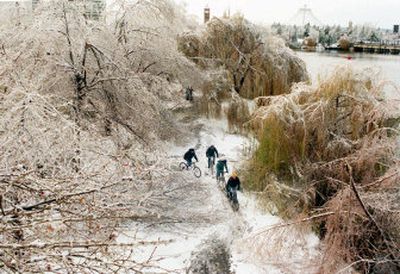Ice storm: 10 years later

Ten years ago today the Inland Northwest was sheathed in crystal. The combination of wet snow and freezing rain that hit Nov. 19 became known as ice storm ‘96. It knocked out power to roughly 100,000 homes, some for as long as 13 days. Four people died. Travel proved nearly impossible. Residents huddled around fireplaces, read by lantern light
and cooked over camp stoves. The damage was estimated at more than $22 million.
Trees were encased in more than a half inch of ice, and the weight became too much. Branches snapped, and limbs fell by the thousands. Many landed on power lines. Line crews for Washington Water Power Co., now Avista Corp., worked 18-hour shifts as the company faced the worst crisis in its 107-year history.
“I recognized it as an ice storm right away,” said Jim Flott, Spokane city urban forester at the time. “I knew all hell was about to break loose.”
Flott, now owner of Community Forestry Consultants, remembered driving around the night of Nov. 19. The only light cast on the city came from the blue arcs of power lines snapping. Hour by hour, the Inland Northwest faded to black.
A decade later, the newspaper clippings have been put aside. Parents tell the story to grade-school children who hadn’t been born when the storm struck. But there are visible scars on Spokane’s urban forest left from the worst ice storm to hit the area in the 115 years the National Weather Service has kept records. Dead branches still hang in some of Spokane’s maples, oaks and pines. The stumps are gray where some trees were lost.
It was an arborist’s nightmare.
Karen Haskew, Coeur d’Alene urban forester since 1988, estimated Tubbs Hill, the city’s 120-acre shoreline park, lost about 1,200 trees. The ice claimed another 100 Coeur d’Alene street and park trees.
Of Spokane’s 70,000 street and park trees, about 5,000 were damaged to the point they should have been removed, Flott said. About 1,500 were taken down within the first two months, using federal emergency management money; the other 3,500 trees still stand.
The failure to remove all the trees is the result of “no money, no interest and no funding for the program,” said Flott, who left his job with the city April 26, Arbor Day.
Jeff Perry, an arborist who worked with and replaced Flott, agreed. Both experts said damage could have been limited if homeowners had done more to care for their trees.
“Ice storm was a baby from the standpoint of ice storms” in other parts of the region, said Flott, who grew up witnessing similar storms in the Midwest. “The structural shape of our trees was the reason why ice storm was so devastating.”
Rich Baker, Spokane commercial arborist and teacher, said the trees he tends for customers typically suffered less damage.
“Because of the structural faults that were not addressed through pruning, there was more surface for the ice to accumulate on,” Baker said.
But there’s only so much weight a branch can withstand before it fails, he added.
A Washington Water Power report by then-CEO Paul Redmond two months after the storm addressed expanded tree trimming. The company averaged $4 million a year in tree trimming over the previous four years, the report said.
“Given the severity of the storm and the type of damage incurred, even a greatly expanded tree trimming effort would not have significantly prevented the widespread outages,” it concluded.
The utility company had a major tree trimming project on the South Hill during summer 1995, and trees there suffered as much damage as in other neighborhoods, the report said.
“It had more to do with the geographic and the spatial distribution of the ice,” said Sharon Vore, Avista systems forester and certified arborist. “It didn’t really have anything to do with the species or the type of tree or the condition of the tree. Where the ice was the heaviest, certain trees broke a certain way.”
Since the day of the urban forest upheaval, Spokane has been slow to replant trees.
Perry said 100 trees are planted in the average year in parks and for neighborhood development. The primary source of money to buy trees is the Reforest Spokane Fund, paid for by citizen donations.
One thousand trees in 10 years is “a drop in the ocean,” Flott said. “We should be planting that in one year.”
In Coeur d’Alene from 1998 through 2005, 3,700 trees were planted in public rights-of-way and another 886 in parks, cemeteries and other places, Haskew said. More than 500 trees were removed or lost for various reasons in that time.
“There are still ways we haven’t fully recovered,” Haskew said. “We still have some street trees with broken branches on them that are probably from the ice storm.”